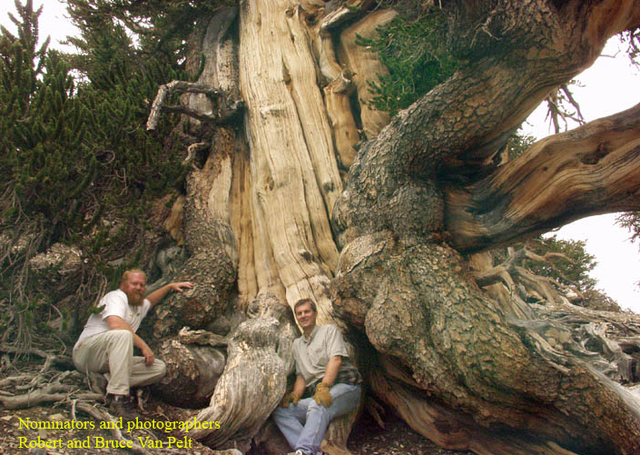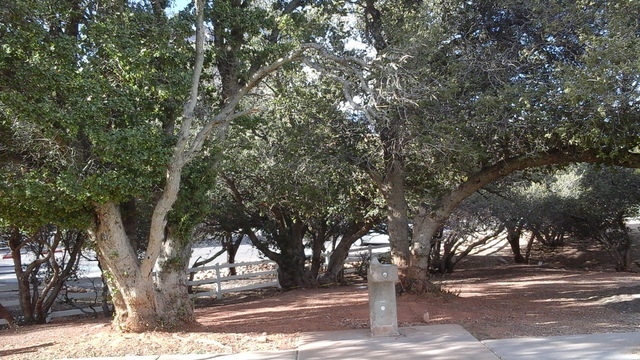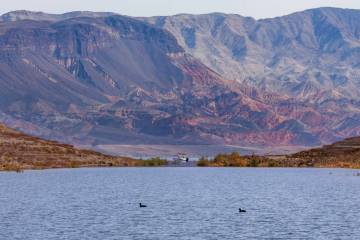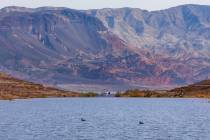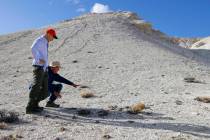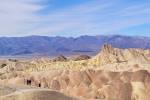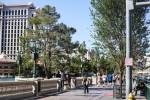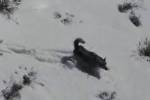Forest aficionados search tall and wide for Nevada’s champion trees
The Nevada Division of Forestry has a big surprise for those who think of the Silver State as a treeless wasteland.
Nevada is actually home to a long list of impressive trees, including two champion specimens, both just outside Las Vegas, that rank as the largest of their kind in the nation.
For the past 24 years, the state forestry division has maintained something called the Nevada Big Tree Register to track the largest and most impressive trees. The list was last updated in 2015 and now contains more than 300 different species.
It also lists “up-and-coming trees” that could grow large enough to reach champion status one day.
Reno resident Rod Haulenbeek serves as editor of the register, a painstaking job that requires him to find and measure every existing champion and new nominee.
“They’re spread out all over the state. You can’t do it in a weekend,” said Haulenbeek, who started as a volunteer and now works as a consultant to the forestry division.
Haulenbeek is credited with nominating 32 of the entries on the list, but he said he has been directly involved in finding another 60 or so of Nevada’s champion trees.
“I’m a tree geek,” he explained. “On the current list, I’ve measured all but seven out of 307.”
The only ones he’s missed are in places too rugged or remote for the 73-year-old to reach. “I’m at the age where I know when I’m out of my element,” he said.
The state’s first big tree registry was completed in 1993 and included 34 specimens. It has been revised and expanded four times since then, with Haulenbeek at the helm for the two most recent updates in 2011 and 2015.
It’s no easy task, according to John Christopherson, natural resource program manager for the state forestry division. “Every tree gets looked at and remeasured and re-verified,” he said.
Work on the latest revision actually began in August 2014 and resulted in the addition of about 30 new tree types to the list. Haulenbeek said 28 trees lost their champion status this time around because they were cut down or surpassed in size by other members of their species.
Champion trees are not merely tall. The largest of the species is determined using a combination of height, trunk width and the spread of the branches or “crown.”
Points are awarded for each measurement — one point for every foot of height; one point for every inch of the trunk’s width 4½ feet above the ground; one-quarter of a point for every foot of crown spread.
So the largest tree in the state, at least based on its point total, is a Fremont cottonwood south of Reno that some locals have nicknamed “el viejo,” or “the old one.”
The tallest tree in Nevada is a 159-foot-tall Jeffrey pine in Douglas County. The largest circumference tree is the state champion Great Basin bristlecone on Mount Charleston, with a trunk measuring 12 feet in diameter.
That bristlecone is one of two national championship-worthy trees in Nevada, both of which can be found within 40 miles of the Strip. The other is a turbinella oak that shades the picnic area at Spring Mountain Ranch State Park in Red Rock Canyon National Conservation Area.
Neither is currently on the National Register of Big Trees, a list of champions maintained since 1940 by the nonprofit conservation group American Forests.
“They will be nominated,” Haulenbeek said.
All told, Clark County is home to about 50 state champion trees. Seven champions and three up-and-comers can be found at UNLV, where the entire campus serves as one big arboretum. Three more champions grow at the Winchester Cultural Center, a county-run park near Desert Inn Road and McLeod Drive in the central valley.
Of the more than 300 trees on the latest registry, only 54 are native to Nevada.
The national big tree register mostly excludes non-native species, but a similar restriction in Nevada would dramatically shrink the state’s list. “That would be no fun,” Christopherson said.
“Nevada is probably the least forested state in the nation in terms of native species because we’re such an arid state,” he said. “If you did biggest (native) shrubs in the state, then we’d be in business.
“Tree measurements are collected using such forestry tools as a low-tech Biltmore stick, a clinometer or, most accurate of all, a laser hypsometer. ‘That’s about 400 bucks,” Haulenbeek said.
When he’s out checking the champions, he also makes note of their general condition, since many of the largest trees are also the oldest.
Christopherson said he sees the registry as a way to foster more public interest in the value of individual trees and build “a greater awareness and appreciation for forests,” both the natural kind and the urban variety.
Haulenbeek said he wants people to consider it a challenge.
“To me, the word is encouragement. I can’t find all these trees myself. We need other people to find them,” he said. “There are more out there to be found.”
Contact Henry Brean at hbrean@reviewjournal.com or 702-383-0350. Find @RefriedBrean on Twitter.




